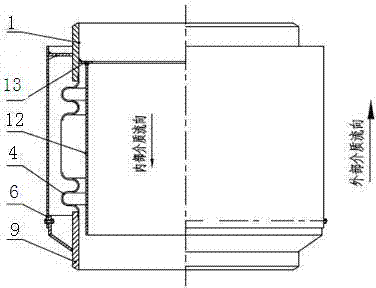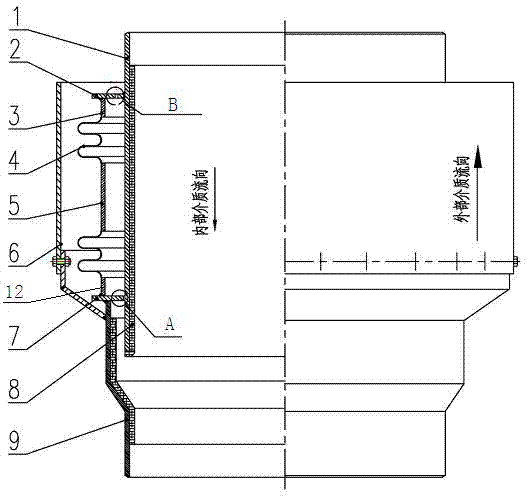Expansion joint used for cyclone separator
A technology of cyclone separator and expansion joint, which is applied to expansion compensation devices for pipelines, pipes/pipe joints/fittings, mechanical equipment, etc. Problems such as the decline of separation efficiency can ensure long-term safe operation, solve the problem of cracking or even falling off of connecting welds, and improve the ability to compensate for multi-directional thermal expansion displacement.
- Summary
- Abstract
- Description
- Claims
- Application Information
AI Technical Summary
Problems solved by technology
Method used
Image
Examples
Embodiment Construction
[0019] The present invention is described in conjunction with accompanying drawing and specific embodiment:
[0020] Such as image 3 As shown, an expansion joint for a cyclone separator device, the expansion joint includes an outlet end pipe 9, an inlet end pipe 1 and a corrugated pipe 4 that act as a flow guide; the inlet end pipe 1 that acts as a flow guide One end of the pipe is connected to the equipment through a connecting pipe, and the other end is located in the outlet pipe 9; the inner diameter of the inlet pipe 1 and the connecting pipe that act as a guide is the same as the inner diameter of the connected equipment, so that the flue gas can pass through smoothly The expansion joint avoids the impact of high-speed flue gas on the guide tube, which is beneficial to the protection of the bellows; the inner walls of the inlet end pipe 1 and the outlet end pipe 9 that play a role in diversion have wear-resistant linings 8; the bellows 4 is two groups, and the bellows 4...
PUM
 Login to View More
Login to View More Abstract
Description
Claims
Application Information
 Login to View More
Login to View More - R&D
- Intellectual Property
- Life Sciences
- Materials
- Tech Scout
- Unparalleled Data Quality
- Higher Quality Content
- 60% Fewer Hallucinations
Browse by: Latest US Patents, China's latest patents, Technical Efficacy Thesaurus, Application Domain, Technology Topic, Popular Technical Reports.
© 2025 PatSnap. All rights reserved.Legal|Privacy policy|Modern Slavery Act Transparency Statement|Sitemap|About US| Contact US: help@patsnap.com



